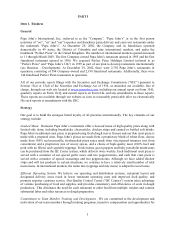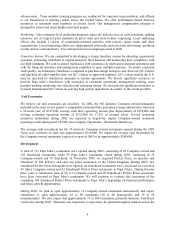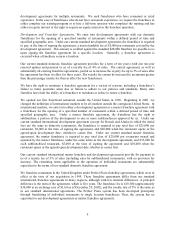Papa Johns 2002 Annual Report Download - page 14
Download and view the complete annual report
Please find page 14 of the 2002 Papa Johns annual report below. You can navigate through the pages in the report by either clicking on the pages listed below, or by using the keyword search tool below to find specific information within the annual report.13
negotiation of suitable lease or financing terms, constraints on permitting and construction of restaurants,
higher than anticipated construction costs, and the hiring, training and retention of management and other
personnel. Accordingly, there can be no assurance that system-wide, Papa John’s will be able to meet
planned growth targets, open restaurants in markets now targeted for expansion, or continue to operate in
existing markets.
2. The restaurant industry is intensely competitive with respect to price, service, location and food
quality, and there are many well-established competitors with substantially greater financial and other
resources than the Papa John’s system. Some of these competitors have been in existence for a
substantially longer period than Papa John’s and may be better established in the markets where
restaurants operated by us or our franchisees are, or may be, located. A change in the pricing or other
marketing or promotional strategies of one or more of our major competitors could have an adverse
impact on sales and earnings of our system-wide restaurant operations.
3. An increase in the cost of cheese or other commodities could adversely affect the profitability of
our system-wide restaurant operations. Cheese costs, historically representing 35% to 40% of our food
cost, and other commodities are subject to seasonal fluctuations, weather, availability, demand and other
factors that are beyond our control. Additionally, sustained increases in fuel and utility costs could
adversely affect profitability of our restaurant and QC Center businesses.
4. Changes in consumer taste, demographic trends, traffic patterns and the type, number and location
of competing restaurants could adversely affect our restaurant business.
5. System-wide restaurant operations are subject to federal and state laws governing such matters as
wages, working conditions, citizenship requirements and overtime. A significant number of hourly
personnel employed by our franchisees and us are paid at rates related to the federal minimum wage.
Accordingly, further increases in the federal minimum wage or the enactment of additional state or local
“living wage” proposals will increase labor costs for our system-wide operations. Additionally, labor
shortages in various markets could result in higher required wage rates.
6. Any or all of the factors listed in 1. through 5. potentially adversely impacting restaurant sales or
costs could be especially harmful to the financial viability of franchisees in under-penetrated or emerging
markets. A decline in or failure to improve financial performance for this group of franchisees could lead
to unit closings at greater than anticipated levels and therefore impact contributions to marketing funds,
PJFS and support services efficiencies and other system-wide results.
7. Our domestic and international operations could be negatively impacted by significant changes in
international economic and political conditions. In addition, our international operations are subject to
additional factors, including currency regulations and fluctuations, cultures and consumer preferences,
diverse government regulations and structures, availability and cost of land and construction, ability to
source high quality ingredients and other commodities in a cost-effective manner, and differing
interpretation of the obligations established in franchise agreements with international franchisees.
Accordingly, there can be no assurance that our operations will achieve or maintain profitability or meet
planned growth rates.
8. Our planned conversion of Perfect Pizza restaurants to Papa John’s restaurants represents the first
time we have attempted to expand the Papa John’s brand in this manner. There can be no assurance that
all conversion issues will be identified and successfully addressed in a timely, cost-effective manner or
that the existing Perfect Pizza market share can be successfully converted to Papa John’s.
























